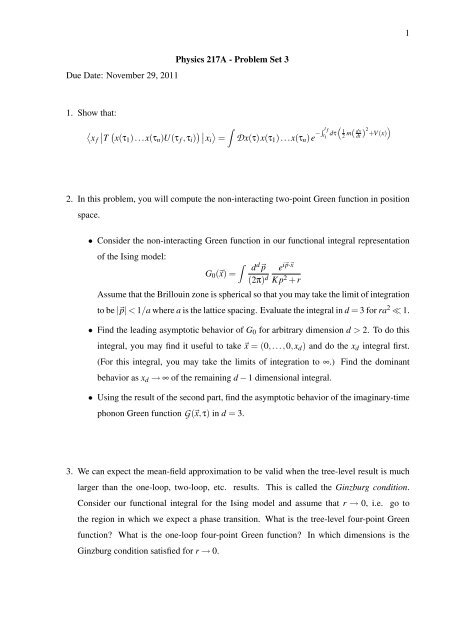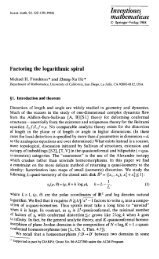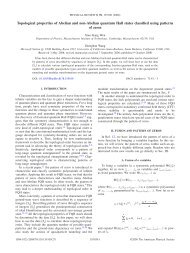1 Physics 217A - Problem Set 3 Due Date: November 29 ... - Station Q
1 Physics 217A - Problem Set 3 Due Date: November 29 ... - Station Q
1 Physics 217A - Problem Set 3 Due Date: November 29 ... - Station Q
Create successful ePaper yourself
Turn your PDF publications into a flip-book with our unique Google optimized e-Paper software.
1<strong>Due</strong> <strong>Date</strong>: <strong>November</strong> <strong>29</strong>, 2011<strong>Physics</strong> <strong>217A</strong> - <strong>Problem</strong> <strong>Set</strong> 31. Show that:〈x f∣ ∣ T ( x(τ 1 )...x(τ n )U(τ f ,τ i ) )∣ ∣x i〉=ZDx(τ)x(τ 1 )...x(τ n )e −R t (ft idτ 12m( dxdt ) 2 )+V (x)2. In this problem, you will compute the non-interacting two-point Green function in positionspace.• Consider the non-interacting Green function in our functional integral representationof the Ising model:ZG 0 (⃗x) =d d ⃗p(2π) de i⃗p·⃗xK p 2 + rAssume that the Brillouin zone is spherical so that you may take the limit of integrationto be |⃗p| < 1/a where a is the lattice spacing. Evaluate the integral in d = 3 for ra 2 ≪ 1.• Find the leading asymptotic behavior of G 0 for arbitrary dimension d > 2. To do thisintegral, you may find it useful to take ⃗x = (0,...,0,x d ) and do the x d integral first.(For this integral, you may take the limits of integration to ∞.) Find the dominantbehavior as x d → ∞ of the remaining d − 1 dimensional integral.• Using the result of the second part, find the asymptotic behavior of the imaginary-timephonon Green function G(⃗x,τ) in d = 3.3. We can expect the mean-field approximation to be valid when the tree-level result is muchlarger than the one-loop, two-loop, etc. results. This is called the Ginzburg condition.Consider our functional integral for the Ising model and assume that r → 0, i.e. go tothe region in which we expect a phase transition. What is the tree-level four-point Greenfunction? What is the one-loop four-point Green function? In which dimensions is theGinzburg condition satisfied for r → 0.
24. Recall that we can represent a vector ⃗Ω in terms of a spinor z α according to ⃗Ω = z ∗α ⃗σ αβ z β .Usingand)∗α dzα ∗α dzα dz∗α2iδ(z = δz − δzαdτ dτ dτδ⃗Ω = δz ∗α ⃗σ αβ z β + z ∗α ⃗σ αβ δz βshow that)∗α dzαδ(zdτ= δ⃗Ω ·⃗Ω × d ⃗ΩdτYou may find it useful to use the identityε abc σ a α 1 β 1σ b α 2 β 2σ c α 3 β 3= 2i ( δ α1 β 3δ α2 β 1δ α3 β 2− δ α1 β 2δ α2 β 3δ α3 β 1)Extra credit: prove this identity.








